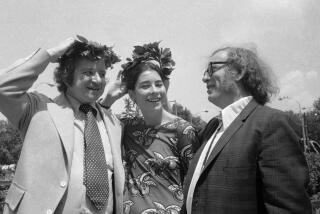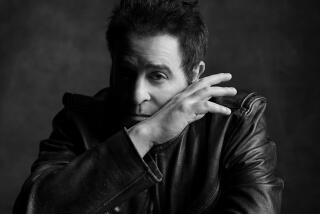Beat Icon William S. Burroughs Dies at 83
William S. Burroughs, whose ragged, scatological, experimental prose made him a seminal figure of the Beat Generation and later a guru to the hippie and punk rock movements, died Saturday at age 83.
Burroughs died in Lawrence, Kan., about 24 hours after suffering a heart attack, said his longtime publicist, Ira Silverberg.
Although in failing health, Burroughs had recently performed in a video with the rock band U2 and read from his work to musical settings by the rap group Disposable Heroes of Hiphoprisy. He had also been working with Silverberg on a new edition of his selected works.
Along with Allen Ginsberg and Jack Kerouac, Burroughs helped found the Beat Generation literary movement with its frank descriptions of drug addiction, sexual excess and petty criminality.
The three shared a New York apartment in 1945, with Burroughs, the eldest of the three, acting the role of literary inspiration and guide to the lowlife haunts of the big city. The impact that the upper-crust WASP had on the Jewish youth from New Jersey and the working class French Catholic from Massachusetts was to change American letters irrevocably.
âBurroughs had conducted lay analytical sessions with his junior partners, and had introduced them to the esoteric in literature and the exotic in street life,â wrote Oliver Harris, in the introduction to his collection of Burroughsâ letters.
Although the three never again lived in proximity--Burroughsâ expatriate sensibilities kept him moving from country to country, scandal to scandal--the three kept in close contact throughout their lives.
Ginsberg was blunt in assessing Burroughsâ impact on his writing. âHe showed me the world,â Ginsberg said not long before his death.
Burroughs was born in St. Louis, the grandson and namesake of the inventor of the adding machine, and graduated from Harvard University in 1936. But he turned his back on a life of privilege and respectability to sample drugs and traffic in outrageous, largely self-destructive behavior.
His best known work, âNaked Lunch,â published in 1959 in Europe, is a torrent of sexual and psychedelic images. Much of the book is written in a stream of consciousness style, and the prose is meant to repel, even nauseate, the reader with descriptions of bodily functions, sex acts and grotesque medical procedures.
âWilliam Burroughs opened the door for supporters of freedom of expression,â Silverberg said. â âNaked Lunchâ was a journal of the horror of addiction. It was a brutally important work.â
One story, possibly apocryphal, was that the bookâs odd title came from Ginsberg misreading Burroughsâ writing of the words ânaked lust.â
No less a literary light than Norman Mailer has praised âNaked Lunchâ as a daring assault on conformity and the growing dehumanization of America. Others found it to be gibberish masquerading as social commentary. The book was the object of a landmark obscenity trial before being published in the United States in 1962.
Burroughsâ heroin addiction, irascible personality and latent homosexuality contributed to an emotional turmoil for which constant movement seemed to bring only temporary relief. He lived in Texas, New Orleans, Mexico City, South America, Morocco, Paris and London.
His movements often seemed dictated by a growing anger at his native country. âI am not able to share your enthusiasm for the deplorable conditions which obtain in the U.S. at this time,â he wrote to Ginsberg in 1949 from Mexico City. âI think the U.S. is heading in the direction of a socialistic police state similar to England and not too different than Russia.â
It was in Mexico City that Burroughs was involved in an incident that became the core of the Burroughs mystique as the prototypal hard-drinking, firearm-loving writer always living on the edge of madness and murder.
After a day of drinking and drugs, Burroughs accidentally shot and killed Joan Vollmer, his second wife, who had remained with him despite his homosexuality. The circumstances of the killing were never fully investigated, and Burroughs fled Mexico City for South America rather than stand trial.
One story had it that he had been reenacting the William Tell story when he tried to shoot a glass off Vollmerâs head and instead shot her in the forehead.
Vollmerâs death and the 1981 death of their son, Bill Jr., of cirrhosis of the liver due to drinking and drug use, were said to have contributed to Burroughsâ unstable mental condition in latter decades.
âThe death of Joan brought me in contact with the invader, the Ugly Spirit and maneuvered me into a lifelong struggle,â he once said, âin which I had had no choice except to write my way out.â
In his âWith William Burroughs: A Report From the Bunker,â Victor Bockris found that Burroughs, during his stay in New York City in the 1970s, lived an odd lifestyle: surrounded by a coterie of young men who catered to his every whim and fearful of leaving his home. When he ventured out, he was always armed with tear gas.
In 1981, he moved to Lawrence at the suggestion of James Brauerholz, who became his secretary and encouraged him to do readings in this country and Europe. With the resurgence of the Beat Generation writers, Burroughs became popular with a new generation.
Musicians such as David Bowie, Lou Reed and Patti Smith cited Burroughs as an important influence. Burroughs also hung out with the Rolling Stones.
Though he occasionally seemed to revel in his celebrity and his infamous reputation--one biography was titled âLiterary Outlawâ--Burroughs admitted that notoriety could drain a writerâs imagination.
âInvolvement with his own image can be fatal to a writer,â Burroughs told Bockris. âWas it Yeats who said every man must choose at some point between his life and his work? Artists usually choose the work, and compromises are usually unfortunate. Hemingwayâs life posed a deadly threat to Hemingway as a writer, moving in a wildebeest at a time.â
In some of his books, Burroughs used a jumbled style called cut-ups, with quotations and anecdotes seemingly pieced together randomly. This technique was used more prominently in âThe Soft Machineâ (1961), âThe Ticket That Explodedâ (1962) and âNova Expressâ (1964).
After moving to Kansas, he wrote screenplays, appeared in movies (including âDrugstore Cowboyâ and âTwisterâ) and wrote a comic opera text.
He reported talking to Timothy Leary just before Learyâs death and being reassured that Leary faced death calmly because of his belief in an afterlife.
In one of his last books, âGhost of a Chance,â Burroughs was sorrowful over the demise of the rain forest and pessimistic that humans live in âa vast mudslide of soulless sludge.â
Times staff writer Hugo Martin and Associated Press contributed to this report.
More to Read
Sign up for our Book Club newsletter
Get the latest news, events and more from the Los Angeles Times Book Club, and help us get L.A. reading and talking.
You may occasionally receive promotional content from the Los Angeles Times.








